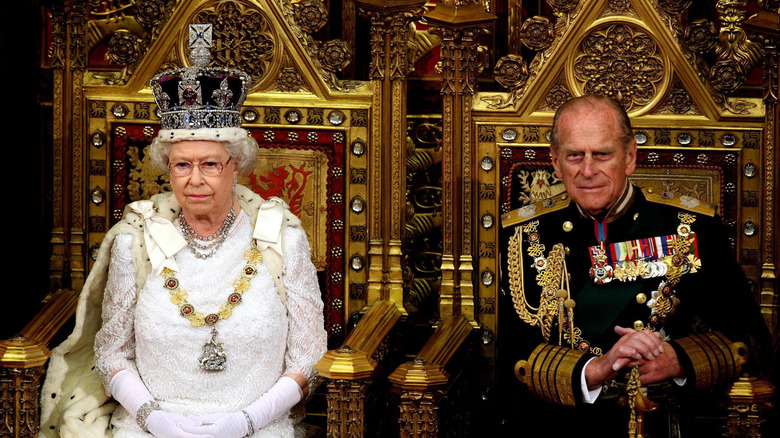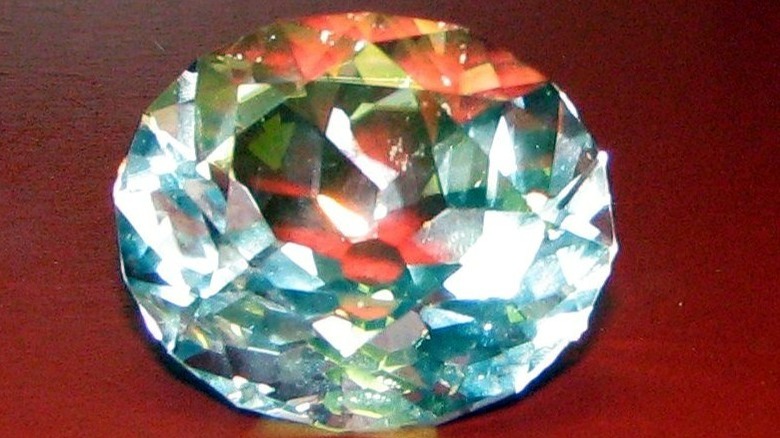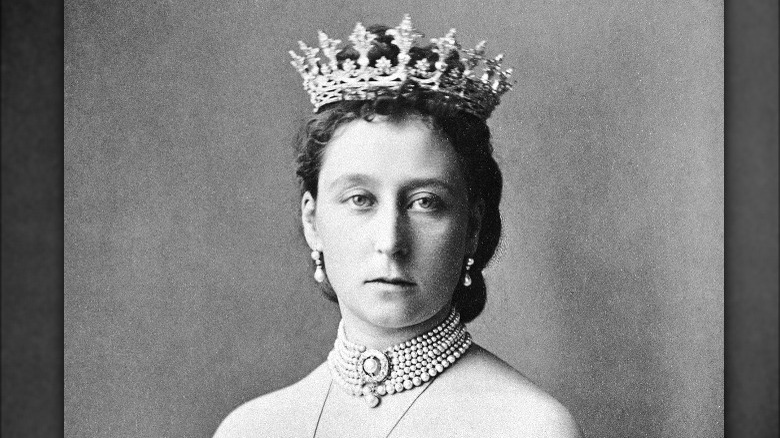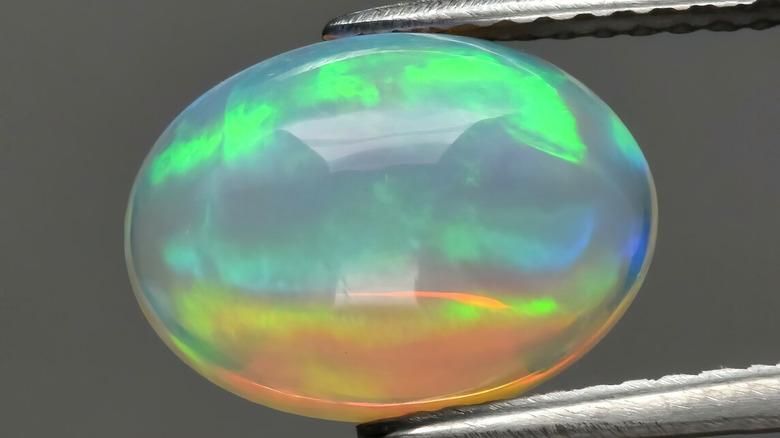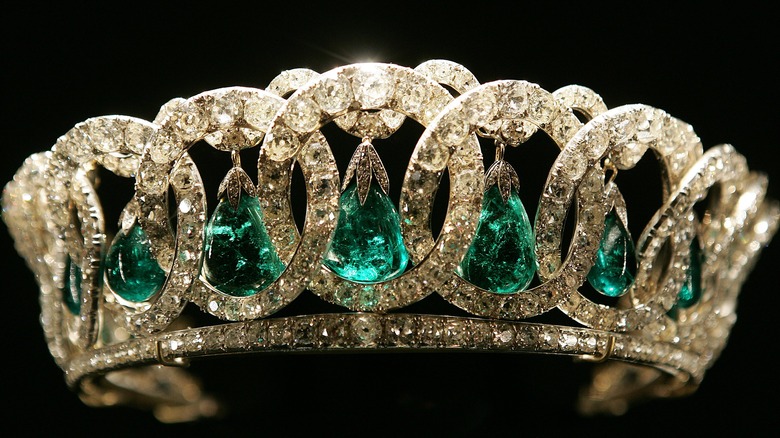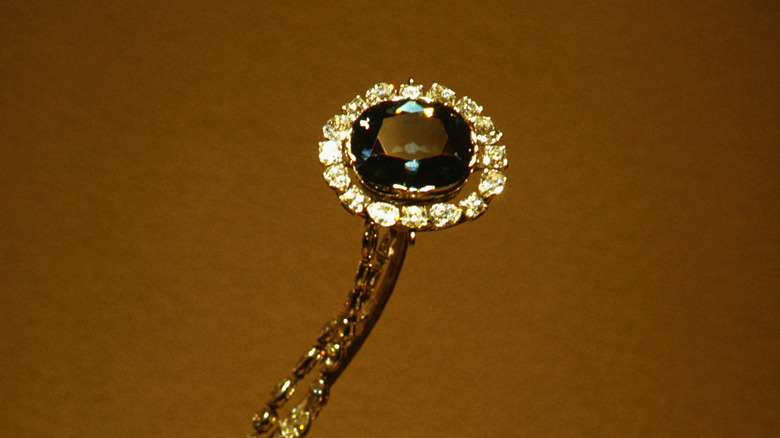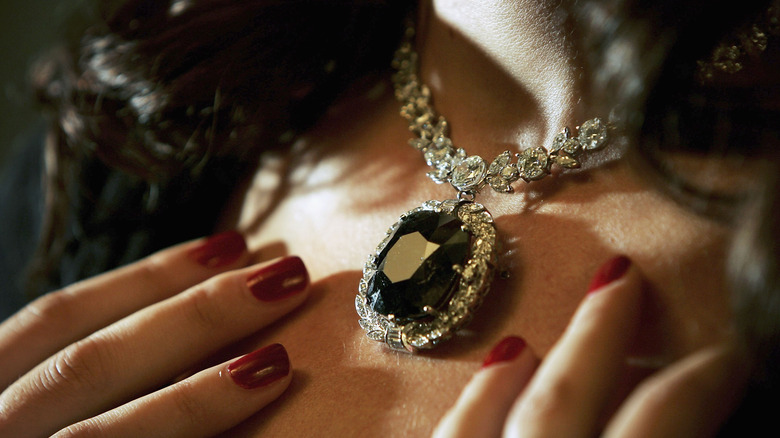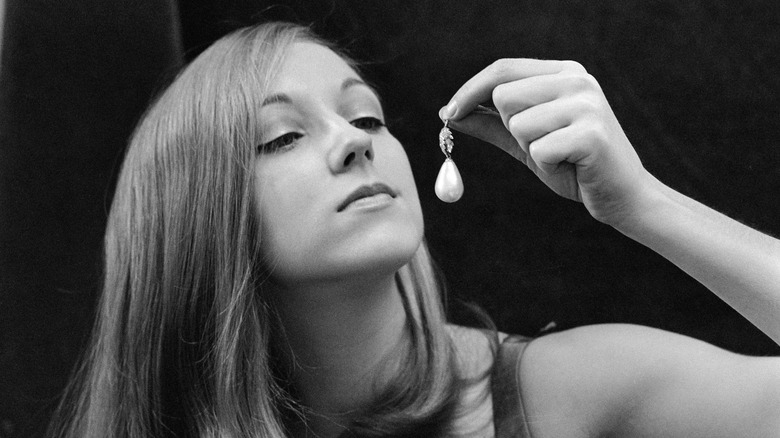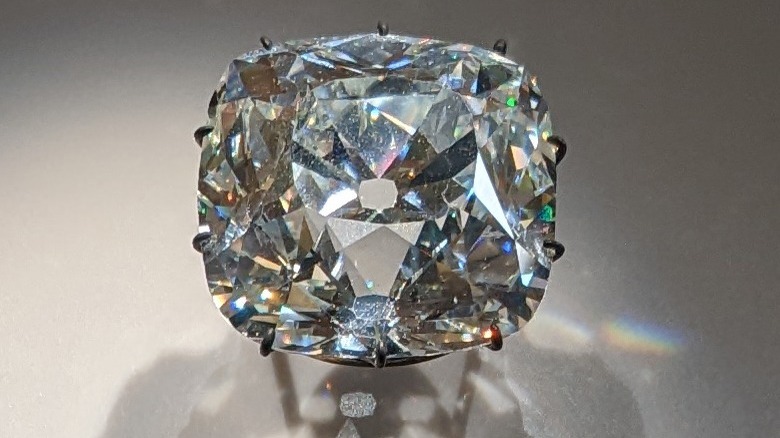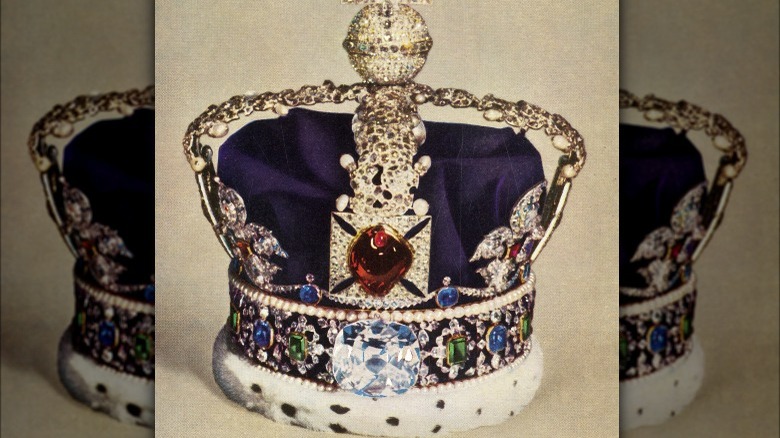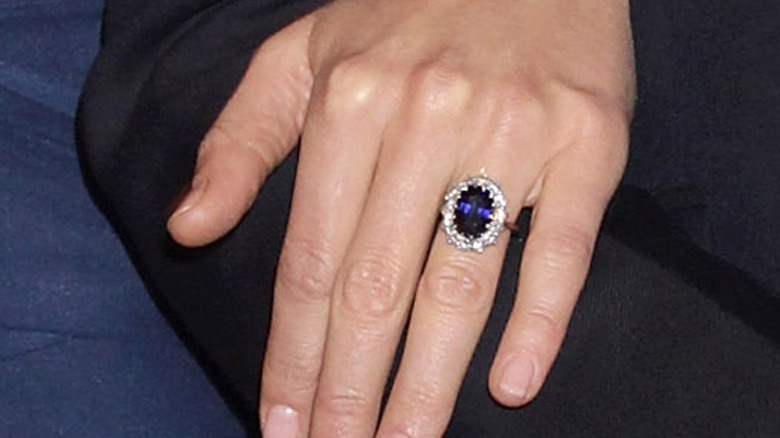10 Royal Jewels That Are Thought To Be Cursed
Diamonds, rubies, and curses, oh my. The royal vault is full of more than just millions of dollars worth of dazzling diamonds and radiant rubies. It's also rich in gems with long, mysterious, and sometimes even cursed pasts.
Many gemstones adorning the fingers, heads, and even necks of royals have turbulent pasts full of murder, mysterious death, revolution, broken relationships, and exile, just to name a few seedy scenarios. While most of the supposed curses are folklore, the reign of terror and treachery of some gem's timelines can be hard to explain away with sheer logic. It seems that death, destruction, and thieving can leave a bad taste in the mouth of karma, causing the jewels to hold a grudge against the wearers.
Take a closer look at these 10 royal jewels with dark pasts, from the diamond that brings misfortune to men to the fatal opal that brought down an entire court. You'll also get a glimpse at a stunning royal sapphire making waves on social media for its turbulent past.
Intrigue of the cursed Koh-i-Noor diamond
When it comes to famous diamonds, the Koh-i-Noor diamond is at the top of everyone's list. This massive 105-carat diamond is currently found within the British monarchy, taking center stage as one of the crown jewels. The jewel didn't make a debut during King Charles III's coronation, but it calls the Tower of London Jewel House home.
The cursed crown jewel has a long and destructive history that goes back centuries. While it's uncertain when the diamond originally started to circulate, the uncut diamond was mentioned in 1306 by Zahiruddin Muhammad Babur (via Texas Independent Jewelry Appraisers). Regardless of when the jewel first started making its rounds through the courts of Hindu, Sikh, and Afghan rulers, it's well-known that the diamond brings misfortune to men that wear it. This ultimate symbol of power pitted dozens of royals against one another in blood-soaked battles before making its way to the East India Company and Queen Victoria.
While Britian's favorite royals might not believe in curses, the jewel was set into a crown that only adorns the female royals, just in case, and hasn't made rounds in social circles since the early 2000s. But, the controversy of the cursed diamond has been trending again as many believe it should go back to India.
[Featured image by Chris 73 via Wikimedia Commons | Cropped and scaled | CC BY-SA 3.0]
Treacherous tiara brings with it bad luck
You might not account one death to a royal tiara being cursed, but when the untimely deaths and devastation start to add up, it might be time for your beautiful diadem to find its way into storage. That's precisely the history of the Strawberry Leaf Tiara that was commissioned by Prince Albert, Queen Victoria's husband, for their daughter, Princess Alice.
Prince Albert, a jewel enthusiast, commissioned a one-of-a-kind tiara, but sadly he died suddenly before even enjoying Alice's wedding. Not willing to part with the cherished gift from her late father, Alice would take the tiara with her to her new Hesse home, only to meet her own young death. The tiara was passed down through the generations of Hesse royalty, leaving misfortune, death, and destruction in its wake. In 1937, the cursed tiara found its way into Prince Phillips' family, only for the curse of death to continue. As historian Dr. Kate Williams told Express, "There was a plane crash, and everyone on board dies ... Awful, terrible, but the tiara survives through the crash, through the wreck, through the fire. So, you see why it's known as the haunted Strawberry Leaf Tiara." With Prince Louis' death, the line of the House of Hesse fizzled out, and so did the terrible reign of the haunted tiara.
Fatal opal that took down the Spanish court
The truth remains a mystery whether a cursed opal truly brought a series of unfortunate events, but the pristine opal mounted in a gold ring of the Comtesse de Castiglione of Italy was eerily present in several Spanish court deaths, according to Gem Select.
Legend — shared in the Chicago Tribune on October 9, 1898 (via The Court Jeweller) — has it that the jewel played a role in a love triangle involving the Comtesse, who took a liking to King Alfonso XII and gifted him the fated opal. But alas, their union was not to be since he married his cousin. Dazzled with the ring, the king slipped it onto the finger of his beautiful wife, who later died.
Upon her death, the ring was bestowed to his grandmother, who was originally reported to have also died soon after (though that was later proven false). The following two wearers of the ring, Alfonso's sister and Mercedes' sister, also died after taking the ring into their possession. However, Gem Select notes potential tuberculosis as a cause. In the end, Alfonso put the ring on himself and died shortly after from organ failure. Possibly a blessing in disguise, Queen Maria Cristina hung the opal around the neck of a statue, and it was lost forever. Whether indeed cursed, it does seem eerie that a gift from a forlorn lover plagued the Spanish court.
Delicate diadem with a destructive past
If only these royal jewels could talk, boy, would they have a captivating story to tell. The Grand Duchess Vladimir Tiara is one such royal piece that could speak volumes since it survived a revolution and the end of the Romanoff dynasty.
PR and Social Media Manager of the jewellerybox, Daena Borrowman, told Express, "It was commissioned from the Romanov court jeweler Bolin by Duchess Marie or Grand Duchess Vladimir after she became the wife of Grand Duke Vladimir Alexandrovich of Russia, the uncle of the last Romanov Emperor, Nicholas II." When the duchess was forced to leave her home during the Romanoff annihilation, she didn't take the tiara with her, thinking it would be safer in the palace. However, once they realized that the Romanoff dynasty wouldn't be on Russian soil again, "her son, Grand Duke Boris, had someone sneak into the Vladimir Palace disguised as a worker and transport all the royal jewels including the Grand Duchess Vladimir Tiara to London where the Grand Duchess' son was living in exile," stated Borrowman.
After her death, the jewels were auctioned off, allowing Queen Mary to bring the beloved Russian tiara into the British court. The late Queen Elizabeth II took a liking to the tiara, and it was worn to many royal events.
Mystery and wonder behind the Hope diamond
Diamonds are the stuff dreams are made of, what kingdoms are forged over, and where curses come to light — especially the Hope Diamond. Coming in at 45 carats of sparkly wonder, this luxurious gem has seen its way through several kingdoms, leaving a path of destruction in its wake.
According to Karl Shuker, Ph.D. in the book "The Unexplained," the Hope Diamond "was apparently unearthed in the Golconda mines by the Kistna River in southwest India, and made its European debut in 1642, when it was bought by a French merchant [who sold it to] King Louis XIV for a handsome profit ... but was mauled to death by a pack of wild dogs." That was merely the first of many strange occurrences of suicide, murder, bankruptcy, and family loss to plague Hope Diamond owners. There was King Louis XIV and Marie Antoinette, who lost their heads; Princess de Lamballe, killed during the French Revolution; King George IV and Lord Frances Thomas Hope, who died in debt; and Sultan Abdul Hamid II, who lost an entire empire.
The Hope Diamond has been part of many royal jewel collections throughout the history of Europe but calls the Smithsonian home today. Some jewels are just too ill-fated to keep within the royal vault.
The world famous cursed Black Orlov Diamond
The history of the Black Orlov diamond is a thing of legends, and whether its origin story is true or not holds some doubt. However, before becoming the Black Orlov diamond, the 195-carat creation was known as the Eye of the Brahma.
Legend has it, the magnificent deep gem was used as Brahma's eye before the gem was stolen and cut down to its current size of a still impressive 67 carats. While stealing a diamond from a god would be enough to call this gem curse-worthy, its tale of ill-will started when three of the owners of the gem died by suicide, including Princess Leonila Galitsine-Bariatinsky and Princess Nadia Vygin-Orlov, the jewel's namesake. Whether the diamond's curse had anything to do with their deaths is shrouded in mystery and speculation; however, all three previous owners did jump to their deaths.
The former royal jewel hasn't been blamed for any deaths since the princesses, but the mystery and intrigue of this former royal jewel haven't lost their appeal. In fact, Felicity Huffman was slated to wear the cursed diamond at the Oscars before abruptly deciding against it. Was it the curse that scared her?
The relationship curse of the La Peregrina Pearl
While some famous royal jewels are known to bring death to those that wear them, the curse of the La Peregrina Pearl is a bit more subtle. This well-known gemstone curses the relationships of those that wear it. Of course, this can't be proven, but looking at a few of its famous owners might make you wonder if this curse holds any water.
While its history is a bit murky, this 56-carat pearl found its way to King Phillip II and Queen Mary I's marriage when it was given as a wedding present. The relationship is well-documented to have gone from one of allies to enemies, with the king leaving her shortly after the marriage to live elsewhere. Upon Mary's death, the king went on to marry again, but true to its curse, the La Peregrina Pearl brought unlucky love. Eventually, the pearl found its way to the absent Queen Julie Clary, wife of Joseph Napoleon, King of Spain. Their marriage wasn't one of great love.
While every owner of the pearl wasn't trapped in a loveless relationship, it eventually ended up in between the tumultuous relationship between Richard Burton and Elizabeth Taylor, sealing its fate as a love curse.
Regent Diamond brings with it misfortune
Big diamonds and misfortune go hand-in-hand. It could just be the fact that these large diamonds are typically owned by royal families that are destined for lineage changes and revolutions, or it could be that these magnificent jewels, like the Regent diamond, carry with them dark origin stories.
A royal symbol of French power, the 140-carat regent diamond was part of the French crown jewel collection for centuries. Legend has it that an enslaved person found the massive gem and smuggled it onto a ship where a captain commandeered it through deadly means and sold it to a merchant who crafted it into a jewel worthy of a crown. Given its deadly beginning, it comes as no surprise that the Regent diamond made its way into the hands of those with unfortunate fates. For example, it was also worn by Marie Antionette, who was beheaded, before being stolen during the French Revolution. It then found its way into the sword of Napoleon Bonaparte, whose reign ended in exile. It also adorned the crown of Louis XVII and Napoleon III, who were exiled from the throne, giving this beautiful stone the curse of misfortune.
No longer held in the royal vault, the Regent diamond currently sits among the diadem of Empress Eugenie in the Louvre Museum.
Darkness surrounds the Black Prince's Ruby
The history of the Black Prince's Ruby's long line of deceit begins with the ruby itself. Despite its name, the gem isn't a ruby; the imposer is a red spinel. However, this discovery wasn't made until this gem found its way into royal history.
The imposter ruby's backstory is full of deceit and mayhem, with the first record of the gem recorded in the same sentence as the murder of Prince Abu Sa'id during its acquisition by Don Pedro the Cruel. Its murderous beginnings lead to the cruel curse following the jewel through Pedro's war with his brother and into the hands of military genius Edward of Woodstock, the Black Prince. After the death of its namesake, the stone was passed down through the generation of kings and even appeared on the helmet of King Henry V during battle, where it's a miracle it survived a decisive blow. Despite the curse, the Black Prince's Ruby earned a prime position on the Imperial State Crown and still sits there.
Sapphire engagement ring with a bad vibe
While some pieces of jewelry are involved in centuries of suspicious deaths, estrangement, and unfortunate events, a royal engagement ring is gaining traction for being cursed among royal fans. The jewelry in question is the spectacular sapphire engagement ring worn by the late Princess Diana and given to the current Princess Catherine by Prince William.
The ring in question is a white gold band with a 12-carat sapphire and an array of diamonds. The cherished gift of Prince Williams' late mother has many speculating that the failed marriage of former Princess Diana and King Charles will follow the current couple. Prince William wasn't buying it, though. During his engagement video with On Demand News, he stated, "It's my mother's engagement ring, so I thought it was quite nice because obviously, she's not going to be around to share any of the fun and excitement of it all. So, this is my way of keeping her close to it all." Will the relationship curse be carried in the ring like the La Peregrina Pearl? The future remains to be seen.
Some jewels seem to carry an ominous vibe around them. But are they truly cursed, or is it just the circumstances surrounding them? Whether you believe in curses or not, as the royals have shown, sometimes it's better to be cautious.
